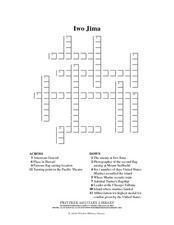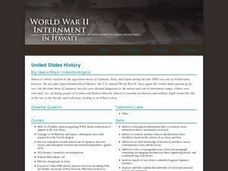Curated OER
A Day of Infamy:Analyzing FDR’s Pearl Harbor Address
In 1941 FDR spoke out on the events at Pearl Harbor. The class will get to analyze word choice, word meaning, author's craft and structure by analyzing an actual draft of this speech. They will look critically at the words used,...
K12 Reader
What's the Purpose? FDR's Pearl Harbor Speech
FDR's December 7, 1941 address to the nation is the focus of a reading comprehension exercise that asks middle schoolers to read an excerpt from the Pearl Harbor speech and determine the president's purpose.
K12 Reader
The Attack on Pearl Harbor
After reading a short passage about Japan's involvement in World War II and why the Japanese attacked Pearl Harbor, readers are asked to analyze how the attack effected the attitudes of Americans who previously had not wanted to go to war.
Polk County Public Schools
The Blame Game for the Loss at Pearl Harbor
Known as the day that will live in infamy, the attack on Pearl Harbor in 1941 was a shock to all. But why was the United States unprepared on that December morning? Study a series of primary sources in a document-based question that...
Student Achievement Partners
Laura Hillenbrand's "Unbroken" and Jeanne Wakatsuki Houston and James D. Houston's "Farewell to Manzanar"
Passages from Unbroken and Farewell to Manzanar provide the context for a study of the historical themes of experiencing war, resilience during war, and understanding the lasting trauma of war. Appendices include extension activities,...
Scholastic
Dear Miss Breed
This compelling plan based on the letters in the book Dear Miss Breed engages readers in learning what it was like for Japanese Americans following the attacks at Pearl Harbor. After reading the letters, young scholars will partake in...
EngageNY
Connecting Ideas in Primary and Secondary Sources: What Led to the Attack on Pearl Harbor?
Let's make some sense of those thoughts! Scholars continue thinking about the different perspectives on Pearl Harbor. They analyze quotes from War in the Pacific, Day of Infamy, and Fourteen-Part Message. Readers tape each quote to chart...
EngageNY
End of Unit 1 Assessment: Fishbowl Discussion, Part 2: Comparing Conflicting Accounts of the Pearl Harbor Attack
Partner up! Scholars continue their fishbowl activity with one partner sitting inside the circle and one sitting outside the circle. Participants add to sentence starters to analyze the perspective of the Pearl Harbor Attack seen in the...
EngageNY
Building Background Knowledge: The Pearl Harbor Attack: Unbroken, Pages 38–47
Perspective changes everything. Scholars use a close reading guide while analyzing pages 38-47 in Unbroken. Readers learn that the governments of Japan and the United States had very different perspectives about the attack on Pearl...
Curated OER
A Boy at War: A novel about Pearl Harbor by Harry Mazer
This A Boy At War PowerPoint introduces the historical context of the novel and information about the novel's author. Facts and trivia about Pearl Harbor that are relevant to the novel's plot are reviewed. Historical photos and a map of...
Curated OER
The Attack On Pearl Harbor: December 7, 1941
In this Pearl Harbor worksheet, learners read about what happened on December 7th, 1941, read Roosevelt's speech in response, and complete activities in the passive voice about what they read. Students write the past participle of 10...
Curated OER
December 7, 1941 - Pearl Harbor
In this writing prompt worksheet, students learn that on December 7, 1941, the Japanese attacked Pearl Harbor in Honolulu, Hawaii. Students research five facts about the event using classroom resources and summarize the facts into their...
Franklin D. Roosevelt Presidential Library & Museum
Pearl Harbor Activity #2: Why Do Words Matter?
Words matter! That's the big idea behind an activity that asks scholars to replace words in FDR's "Day of Infamy" speech with synonyms. They then listen to a recording of President Roosevelt's address and compare his version to their own.
Franklin D. Roosevelt Presidential Library & Museum
Pearl Harbor Activity #4: Who is the Audience?
Young historians use the prompts on a worksheet to analyze President Roosevelt's "Day of Infamy" speech. They identify the intended audience for the speech, the devices FDR used to persuade his audience, the responses promoted, and the...
Curated OER
Writing About Pearl Harbor
Students summarize the reasons why the U.S. entered World War 2. They view a video on the bombing of Pearl harbor, construct a timeline of WWII events, and evaluate propaganda posters to create their analysis of the start of U.S....
Curated OER
Iwo Jima
Here is a crossword puzzle on some of the more important aspects of the Iwo Jima conflict during World War II. There are four words to compose going across, and eight words going down. An answer key is on page two of the worksheet. Good...
Curated OER
My Secret War: Lesson 4
Fifth graders write a speech. In this history lesson, 5th graders define the word infamy and listen to a speech by FDR. Students work in groups to summarize his speech and rewrite sections of the speech.
Curated OER
Pearl Harbor vs September 11 Attack
Students compare and contrast the events of the Pearl Harbor Attack and the attack on September 11, 2001 by examining the similarities and differences between these two events.
EngageNY
Studying Conflicting Information: Varying Perspectives on the Pearl Harbor Attack, Part 1
Scholars read President Roosevelt's Day of Infamy speech and analyze the speech's words using close reading guides. Readers determine Roosevelt's point of view after reading the speech and filling in the guides.
EngageNY
End of Unit Assessment: Fishbowl Discussion, Part 1: Comparing Conflicting Accounts of the Pearl Harbor Attack
Scholars continue discussing Unbroken by using a fishbowl activity. Some readers share thoughts about the Day of Infamy, while others sit and observe the conversation. After the activity, pupils share what they learned.
EngageNY
Studying Conflicting Information: Varying Perspectives on the Pearl Harbor Attack, Part 2
Scholars take another look at Japan's Fourteen-Part Message. They then take turns adding ideas to sentence starters to create ideas about the different perspectives of government. To finish, groups mix and mingle to share their sentences...
Curated OER
Jacob Have I Loved
Eighth graders, while being introduced to Katherine Paterson's novel, Jacob Have I Loved, bring to class three facts about Pearl Harbor. They place the facts they brought to class on a display board. At the conclusion of the teachers...
EngageNY
Building Background Knowledge: “War in the Pacific,” Part 2
Who did what? Readers take a closer look at War in the Pacific to determine each country's actions. As they read, scholars underline American actions in one color and actions of Japan in another. They then begin completing Pearl Harbor...
Curated OER
World War II: Internment in Hawaii
Students examine world history by writing an essay in class. In this World War II lesson, students identify the attack on Pearl Harbor, the response from the U.S and the effect it had on Japanese-Americans. Students define Japanese...
Other popular searches
- Pearl Harbor Wwii
- Attack on Pearl Harbor
- Pearl Harbor Map
- Pearl Harbor Day
- Pearl Harbor Attack
- Social Studies, Pearl Harbor
- Pearl Harbor Lesson Plans
- Pearl Harbor Movie
- Pearl Harbor Crossword
- Pearl Harbor Crossword Puzzle
- Wwii Pearl Harbor Movie
- Bombing of Pearl Harbor

























